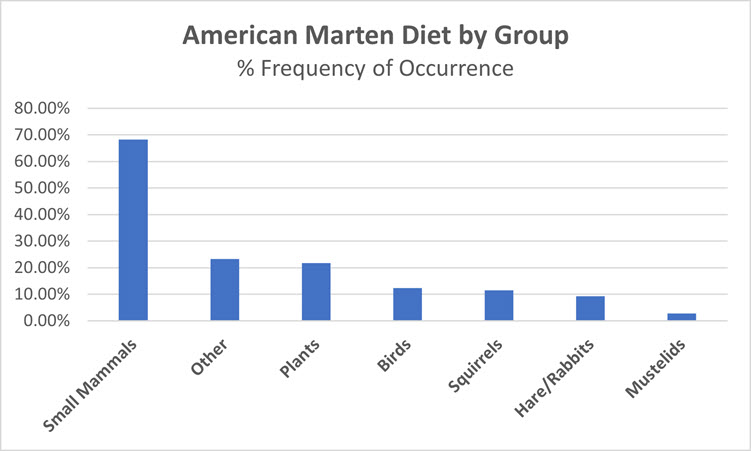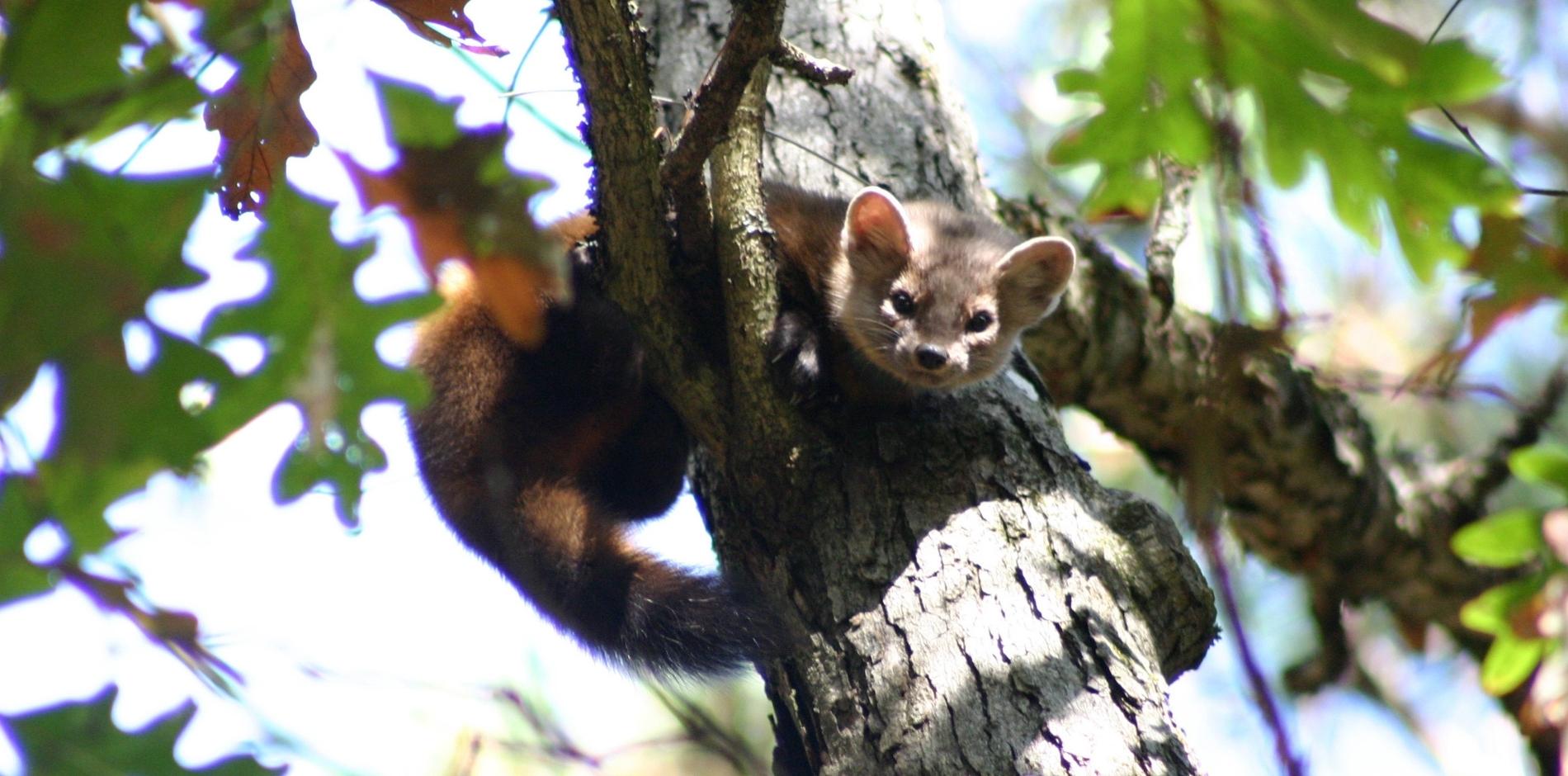Wildlife Note
(Martes americana) Formerly known as the "Pine" marten, this agile climber was a long-time native resident to Pennsylvania prior to extirpation soon after the turn of the 20th century. Now the Pennsylvania Game Commission is seeking to return this iconic species of the forest to Penn's Woods.
- Visit the American Marten story map for a brief overview of the species, history, and feasibility assessment for Pennsylvania.
Biology
Measuring between 19 and 27 inches from nose to tip of tail martens weigh between 1 and 3 pounds. Males are generally heavier than females, sometimes by 65%. Both sexes have dense brownish black hair covering their tails, running up their backs and sides, and onto the tops of their heads. A yellowish orange bib covers the throat and can stretch down to the chest. In winter, a pale, whitish gray color stretches from the ears down under the chin whereas in the summer this area is chocolate brown. Relatively large feet allow for even transfer of weight over snowy conditions while short legs and a narrow body allow for the marten to access holes, cavities, and crevices on the ground and within the trees for hunting, denning or protection. Martens are swift tree climbers and spend a fair amount of time above ground foraging and exploring cavities.
Marten range is vast extending from Alaska, across Canada and down into Maine. New Hampshire, Vermont, and New York all have marten populations while many states within the upper Midwest also have martens. Historically, marten would have ranged down through Pennsylvania, West Virginia, Maryland into Virginia, Tennessee, and North Carolina.
Breeding occurs within July and August and marten, like fisher, exhibit what's called delayed implantation. Fertilized eggs do not immediately implant on the uterine wall and remain un-attached until close to 200 days. Gestation after implantation lasts 27 days and between 1-5 kits are born altricial in March, April, or May. By day 46, young martens are moving out of the den, and by 15 months reach sexual maturity. Some females will produce their first litter at 24 months, although this isn't always the case. Once young martens separate from the female, dispersal can vary between 2.5 – 25 miles with some rare instances over 120 miles. Home range is also variable, and often dependent on both habitat suitability and prey abundance but is consistently larger with males than females. Home ranges between sexes within the upper mid-west average 3.2 mi².
Martens are considered a true facultative generalist, meaning they are opportunistic when it comes to their diet. This leads to a very broad range of diet items including mammals, birds, vegetation, insects, reptiles, amphibians, and fish. Fortunately, a large amount of research is available from across the range when it comes to diet for American martens. The largest proportion of diet is made up of small mammals such as voles, shrews, and mice. The next largest group is plants such as soft mast, grasses and other vegetation. Insects make up a large proportion of marten diet, and is followed by birds, squirrels, and lagomorphs. Martens, like fishers, exhibit intraspecific consumption, or what would be considered cannibalism, eating other martens in some instances.

Sources of mortality for marten are like many other wildlife species with a variety of disease and parasites, exposure as well as starvation. In locations where martens are abundant and seasons exist, trapping is a source of mortality and when in relation with human development, roadkill can occur. Mammalian species predating marten include bobcat, fisher, coyote, red fox, and other martens. Raptor species that prey on marten include the great-horned owl, eagles, and the northern goshawk. Predation increases within areas of poor to non-existent habitat in comparison to relatively low predation in areas of suitable, contiguous habitat. Martens live from 1.5 to 5.5 years with occasional individuals making it to 14.5 years of age.
Habitat
The American marten can inhabit a large variety of forested habitat types depending on available prey and cover despite many believing this species was strictly tied to 'old-growth' coniferous forests. In Pennsylvania, historic records point to marten preferring deciduous, hardwood timber. Across the current range, marten live everywhere from the boreal forests of northern Canada to the high-elevation peaks of the Adirondacks, from the snow packed Rockies to the lower Peninsula of Michigan and the arid Black Hills of South Dakota. This variation of landscapes where marten persist have one thing in common that is critical to the species, structural complexity. Good marten habitat provides structure from the forest floor, through the understory and mid-story to the canopy. Important structure for a marten includes downed woody debris, rock piles, standing or leaning snags, and cavities. Structure on the ground also provides a way to access what is called 'the subnivean' or the world under the snow. Martens hunt and find shelter under the snow during the winter providing for a safe area with little competition. This species can withstand some forest fragmentation, primarily through timber harvest, but does not respond well to human development. Canopy cover is an important factor and protects the marten from predators such as the great-horned owl.
Population
Martens were once a common part of the forest ecosystem within Pennsylvania. Pre-historic records show that marten, at one time, inhabited the forests of the east down into North Carolina and Tennessee. Historic records within Pennsylvania point towards the northern tier of the state, with highest densities found within the counties of Warren, McKean, Potter, Forest, Elk, Cameron, and Clinton. Deforestation of the state occurring in the 18th and 19th centuries paired with unregulated harvest led to the eventual extirpation of the American marten within the Commonwealth. The last remnants of the population likely blinked out by the 1920's. There have been several occurrences since this time but are though to be from dispersing martens traveling from New York.
Several assessments focusing on feasibility of reintroduction have been completed for this species, with the most recent coming in 2022. This assessment focused on available habitat, impacts to and from other species, climatic changes in the future, and a variety of other important factors. This review found that there is suitable habitat within the historic range of Pennsylvania, and that there is little negative impact in relation to other species within the state. It was recommended that marten be reintroduced into the Commonwealth following a reintroduction and management plan being drafted. The Pennsylvania Game Commission Board of Commissioners voted to move forward with the development of a reintroduction and management plan for marten that will be reviewed by the public and provided to the Board for their review and approval.
 (Photo Credits: Robert Sanders)
(Photo Credits: Robert Sanders)